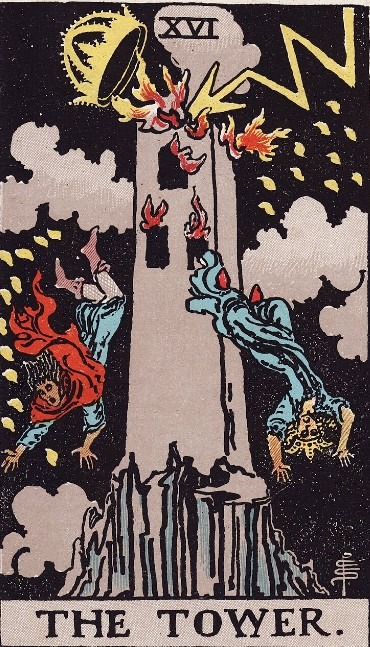
The fool’s journey continues with card 16, the tower struck by lightning. He’s learning about the subconscious, the deepest layer of his psyche.
Fresh from the devil card’s insights into the roots of desires and addictions, he’s now arrived at a symbol of destruction and disaster.
The top of a tower has been cracked apart by lightening. He can smell burning and hear the screams as people fall. The sky is black with storm while the tower itself stands on a rocky promontory.
He remembers the hermit standing tall and straight as a tower, high on a mountain side.
When laid out in three rows of seven, the hermit is directly above the tower, while the hermit himself is below the high priestess. The fool is sure there’s connections between them but the storm is wild and he needs shelter so puts the thought away.

The tower card was not included in the earliest tarots commissioned by the Visconti and Sforza families although it can be found in the Budapest tarot (c1475) and Rosenwald tarot (c1480-1500) as well as the Charles VI cards from the mid 15th century.
Maybe the image was a little too close to home for the Visconti’s in renaissance Italy where tall, thin towers belonging to ruling families were common architectural features.

Towers represented rulership and power so they fell it often signified the fall of the family who owned them. Height was associated with status but with height came the risk of lightning strikes, as well as their susceptibility to earth tremors and quakes.
The Charles VI tarot (late 1400’s) is thought to show the Sforza Castle in Milan, while the Soprafino tower (1840’s) may have been part of the town’s defence.

Early tarots called this card the house of god (maison die) but in the Sola Busca tarot (c1490), the oldest complete tarot deck, the tower card shows a man standing on the ground with a streak of lightning piercing his chest.
This image also appears in the 17th century Mitelli tarot.

The origin of the tower is thought to be biblical.
When god was angry, displeasure often took the form of fire or plague descending from the sky, an image similar to the demolition and ruin of card 16.
Genesis 10 (8-12) tells of the king Nimrod who built the city of Babel, (Genesis, 11:1-9). Nimrod was thrown from a tower by lightning sent from god and the image of people falling from high buildings was a familiar one in medieval Europe.

In Genesis, 19:24-26, the destruction of Sodom and Gomorrah was another example of god’s anger at human disobedience. Not only were the towns destroyed by sulphur and fire, god turned Lot’s wife into a pillar of salt because she looked back after fleeing from her home.
In the Catelin Geofroy deck, the tower uses a similar symbolism but shows the story of Orpheus and Eurydice. In the card, Orpheus is playing music.

He disobeyed the command not to look back as he led his wife out of the underworld and Euridyce is seen being dragged back to Hades.
There are also similarities with the four horsemen of the apocalypse (book of revelation) who unleashed the destructive forces of war, famine, and plague.
The Minchiate tarot returns to the story of Adam and Eve, which the Waite/Coleman Smith tarot used in the lovers.
Card 16 in the Minchiate appears to show Adam and Eve beiing expelled from the garden of eden.
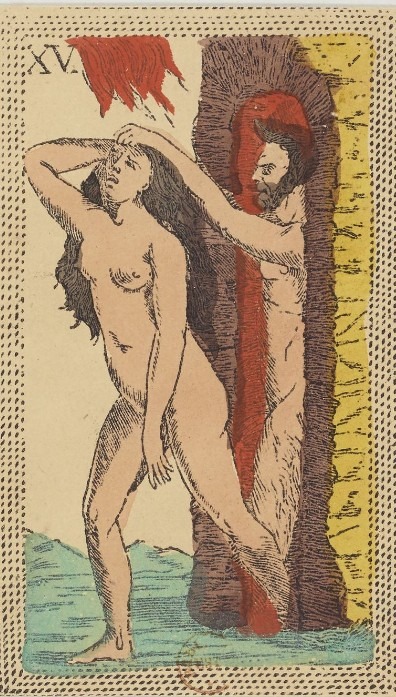
As the tarot moved from Italy to France, the tower was replaced by a tree being struck by lightening and the card was renamed La Fouldre or the lightening.
Examples include the 17th century Jacques Viéville tarot and the 18th century Vandenborre tarot (c1750–1760).

The Tarot de Paris (or Parisian Tarot) calls the tower La Foudre and shows those guilty of sin being taken into the mouth of hell by the devil.

French decks are often generically labelled as Marseilles tarots where the tower became La Maison Dieu (House of God).
The first deck to use this name was the Jean Noblet tarot (c1650) which, like later Marseilles designs showed the tower being struck and destroyed by lightning.
The top of the tower showed a crown, symbolising the fall of a ruling power, often through revolution of the people.

Eliphas Levi, the first of the French occultists to adopt the tarot, claimed the image derived from Babel and Nimrod.
Levi and other occultists shifted focus from the tower to the falling people and linked these with ruin or catastrophe, through pride, greed, and other ego driven desires. The sin of pride was one the seven deadly sins of the early church, and a popular image in medieval times.
The tower card showed failure of materialism was inevitable.
Once a fall begins there is no stopping it, but the disaster which signals the end of plans and ambitions, also brings opportunities for new beginnings.
A fresh start with new knowledge.
Etteilla, pseudonym of Jean-Baptiste Alliette called the card misery and prison while Oswald Wirth and later esoteric decks simply named it the tower.
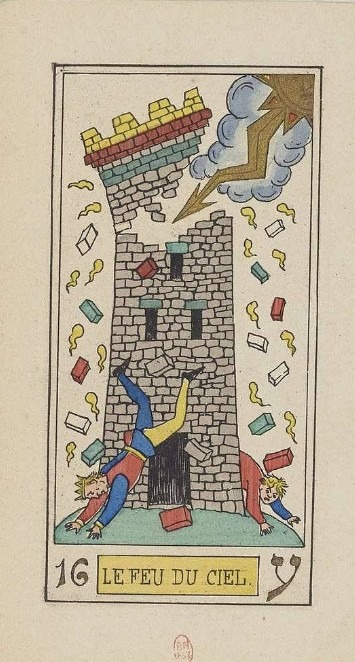
The Waite and Coleman Smith card symbolised the wiping away of materialism.
To focus on brickwork and height was to face the wrong direction.
The physical could be destroyed whereas the non-material or spiritual was eternal.
The intellect can take individuals either away from or towards the truth but the mystery of god, as in the eternal cycles of the natural world, can only be experienced once mistakes and errors of way were faced.
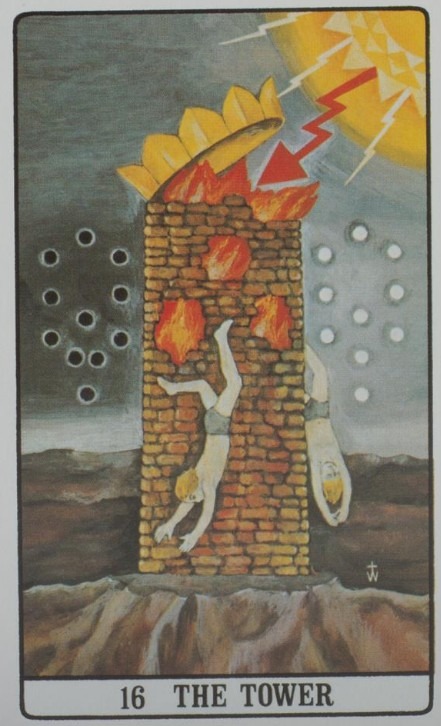
What lessons can the fool learn from this card?
As a psychological tool, the tarot has taken the fool step by step on an inner journey.
He’s seen the structured mechanisms of the world around him, in particular the power of creative action in the magician and inner mysteries guarded by the high priestess.
Here, in the final line, the fool is seeing clearer connections between the previous cards he’s encountered.
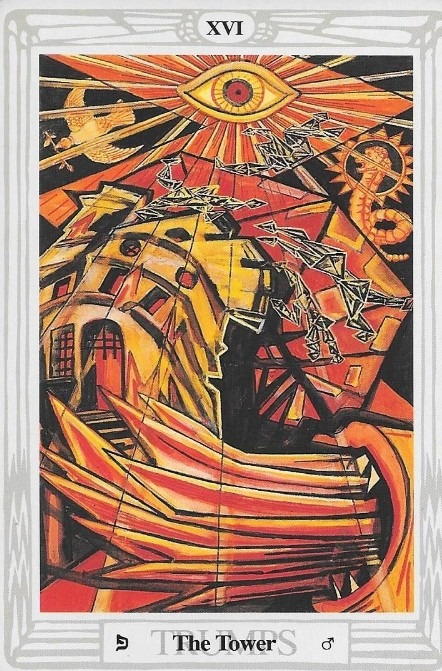
The tower shows the fool the force of nature, which he first saw in the empress, is not always benign. It can also cause upheaval and tragedy.
He’s seen the arid landscape of the emperor, who prioritised success in the physical world, and how the charioteer had no reins so lacked control over the opposing forces of himself and the surrounding world with his chariot trapped and stationary.
Strength offered reassurance and the hermit invited him to step aside to seek knowledge, while the hanged man offered a glimpse of the potential serenity of surrender to forces greater than himself.
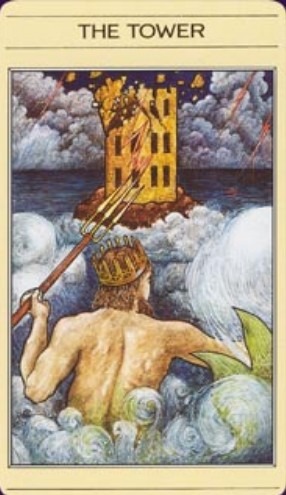
From a psychological perspective, the tower represents the ego.
Death introduced the need to challenge the ego’s control and the fool remembers death in card 13, where a crowned king lay prostrate beneath the hooves of death’s white horse.
One of the figures falling from the tower wears a crown, a symbol of earthly power and control, and the fool is being reminded wealth and prestige can be destroyed, often unexpectedly without warning.
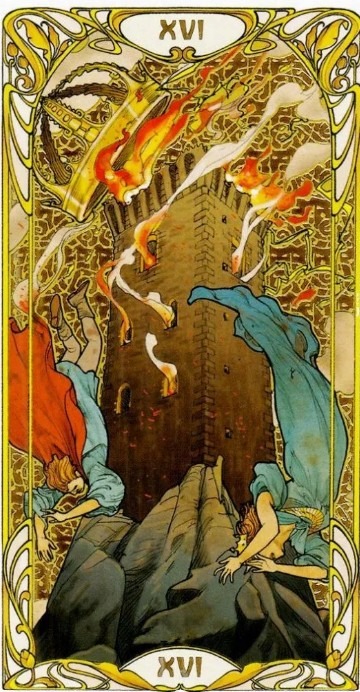
Fresh from meeting the devil in card 15, the fool knows the ego’s power can be overcome.
The tower itself is a symbol of ego satisfaction and fulfilment, the manifestation of desire for wealth, status and fame.
In this card, the tower represents what can happen if ego is left unchecked..
A dominant ego fosters the belief that self-worth can only be measured through possessions and privilege. The more the ego achieves the more it wants.
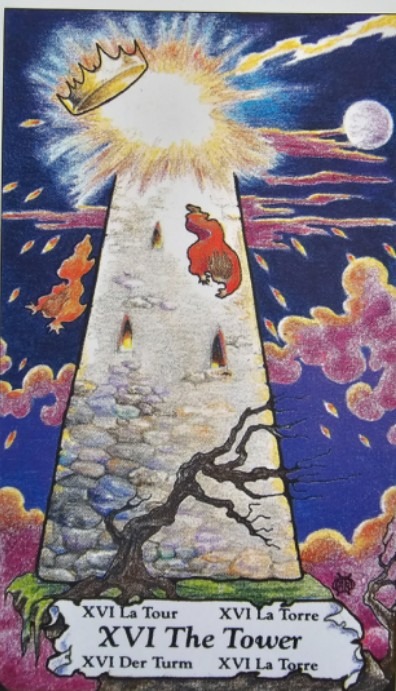
The further the fool might choose to walk down the path of material acquisition, the further he risks finding himself blocked from his inner self and favouring surface rather than depth.
There comes a point where, regardless of possessions, the inner self reaches a state of despair, manifesting as anxiety, depression and an increasing sense of separation.
For a while, activities and substances are used to block reality but they risk becoming essential coping mechanisms, often resulting in further mistakes. In the worse situations, avoidance of reality can ultimately lead to death, either accidental or deliberate.
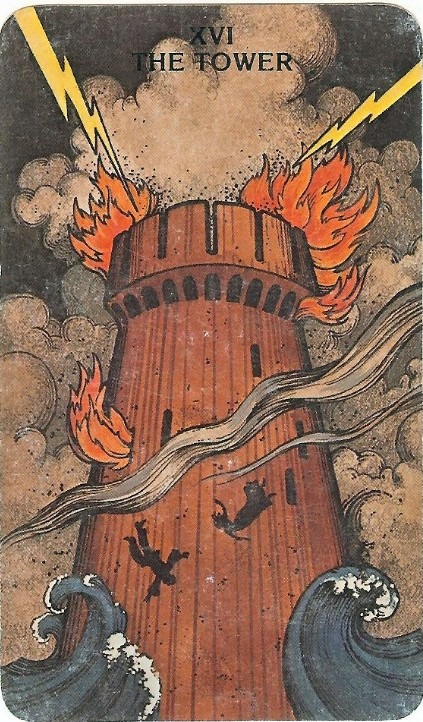
The bolt of lightning on the tower card is an unavoidable force of nature. It destroys the tower by cracking it open, exposing what it contains.
The falling people realise too late the precariousness of their lives but the fool is over two thirds of the way through the major arcana and can now see this destruction is metaphorical as much as literal.
Falling need not be fatal.

The devil showed him the chains that bind are less permanent than he might have once believed.
Escape is possible but the process hard because without inner strength, alongside external guidance and support, the ego will continue to dominate day after day, year after year.
For those who don’t, won’t or can’t free themselves from the ego’s control, it takes an external event to bring everything crashing down.

In card 16, the disaster has happened and the material world is falling apart, but the fool notices how the tower is built on solid foundations.
The top has exploded and people have fallen.
There are flames yet despite the damage, the brick structure remains mostly intact.
Towers can be rebuilt.

A bolt from the blue might be a natural disaster which destroys all that’s familiar; a personal calamity through the death of a loved one or maybe a financial crisis or health scare.
Whatever form it takes, the sudden change in circumstance means a transition.
From this point on, change is possible, be it a recreation of the old or an opportunity to build anew. The experience of destruction reveals the fragility of life which hangs from a single thread and can be cut at any moment.
The outer world has been transformed.

In a tower situation, the fool may feel he’s lost control over his known life and environment.
Separation or redundancy can feel devastating. There is no fear like the loss of health or the grief that comes from bereavement but the cards have shown the fool he has the inner power to manage how he responds.
Sometimes destruction is necessary to clear the way for what lies ahead.
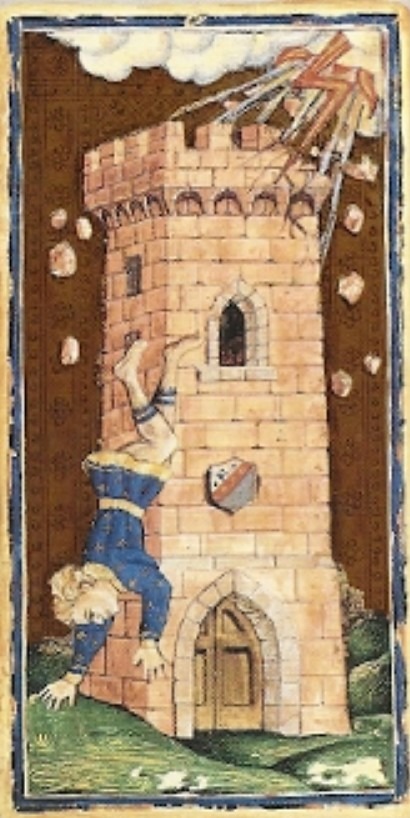
Control over the power of ego leaves the way clear for the fool to delve further into his layers of subconsciousness. Not every disastrous event will make a dramatic difference but they’re potential opportunities for re-evaluation.
When the conscious world we take for granted has vanished, we understand too late what we believed was permanent is always fragile.
In the depth of grief for what is lost, and at the worst times of our lives, there remains a freedom to explore more deeply the aspects of self which so far were hidden.

If we follow the message of the tarot, and accept all life is made from layers of energy, the tower is the door to revelation.
The fool is ready to step into the universal experience of wholeness and unity.
It’s been a long journey.
The next card is the star. It offers another respite. Card 17 is the restoration of peace and calm before the facing the subconscious depths of the moon.
Join the fool as he takes the next step on his walk through the tarot.
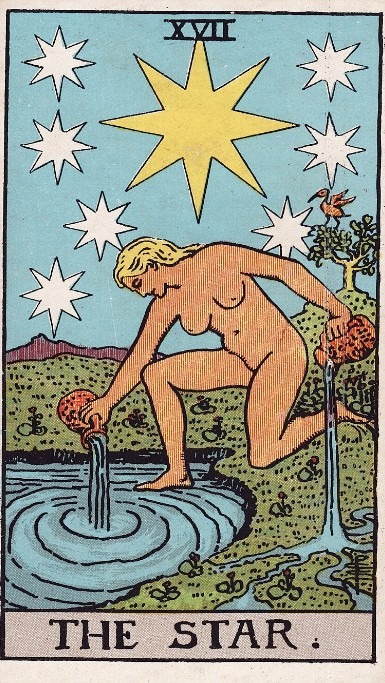
images my own, or copyright free from wikipedia commons and https://pixabay.com/